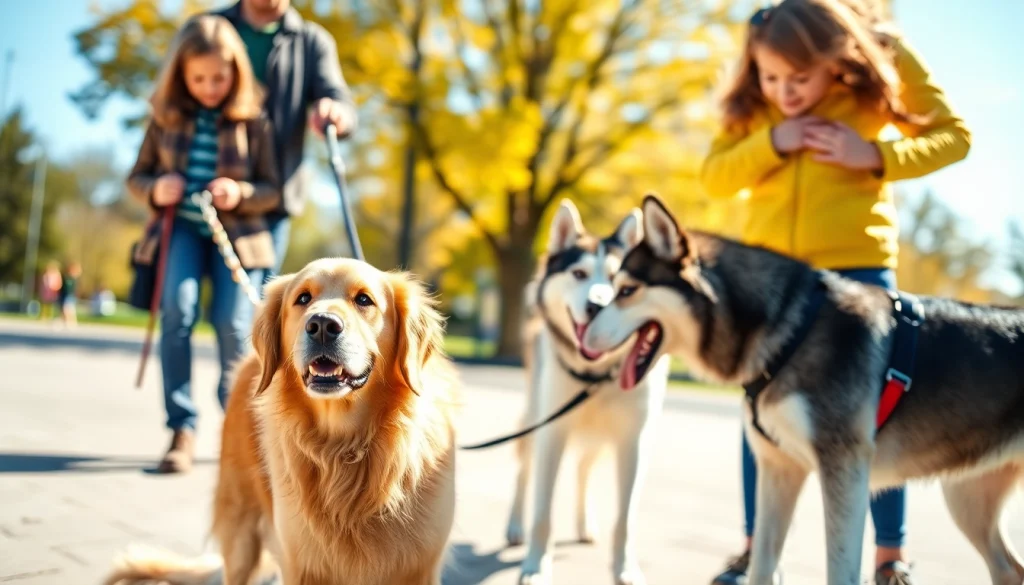Understanding the Role of Service Dogs in Daily Life

What Are Service Dogs?
Definition and Purpose
Service dogs are specially trained dogs that assist individuals with disabilities in performing specific tasks. These tasks are directly related to the person’s disability, enabling them to lead more independent and fulfilling lives. Service dogs can provide support in a variety of circumstances, from guiding individuals with visual impairments to alerting those with hearing loss or helping those with psychiatric conditions navigate their daily lives. The training and skills required for service dogs vary widely based on the needs of the handler, making them versatile companions in a wide array of scenarios. To learn more about the incredible roles service dogs play, visit service dogs websites dedicated to their training and advocacy.
Types of Service Dogs
There are several types of service dogs, each trained to perform specific tasks for individuals with particular needs. Common types include:
- Guide Dogs: Assist blind or visually impaired individuals by navigating obstacles and providing orientation.
- Hearing Dogs: Alert deaf or hard-of-hearing individuals to sounds such as doorbells, alarms, and crying babies.
- Mobility Assistance Dogs: Help individuals with physical disabilities by retrieving items, opening doors, and providing balance support.
- Medical Alert Dogs: Trained to recognize and alert their handlers about medical conditions such as diabetes, seizures, or narcolepsy.
- Psychiatric Service Dogs: Provide support for individuals with mental health conditions, including PTSD, depression, and anxiety, by performing tasks such as grounding techniques and alerting to anxiety attacks.
Legal Recognition and Rights
Service dogs are recognized under the Americans with Disabilities Act (ADA) as essential companions for individuals with disabilities. Under this law, service dogs are permitted in public places, including restaurants, stores, and public transportation. It’s important to understand that the ADA defines service dogs as dogs that are individually trained to do work or perform tasks for people with disabilities. This law provides them certain rights and protections, ensuring that individuals with disabilities can access the necessary support they need in various environments.
Benefits of Service Dogs
Emotional Support and Companionship
Service dogs provide more than just physical assistance; they are also powerful emotional support companions. The presence of a service dog can alleviate feelings of loneliness and anxiety for their handlers. The unconditional love and companionship that dogs offer help in building confidence and improving overall well-being. For many users, their service dog acts as a bridge to engage more fully with the world around them, thus enhancing their social interactions and reducing isolation.
Physical Assistance and Independence
One of the primary benefits of having a service dog is the physical assistance they provide, which can greatly enhance a disabled individual’s independence. Mobility assistance dogs can help individuals who have difficulty walking by providing balance support, fetching items, or even pulling wheelchairs. This assistance allows individuals to navigate public spaces safely and enjoy activities they may have previously found challenging, significantly improving their quality of life.
Impact on Mental Health
The presence of service dogs has been shown to have a profound positive impact on mental health. Numerous studies have indicated that interactions with service dogs can reduce cortisol levels (the stress hormone) while simultaneously increasing serotonin and dopamine levels, which are responsible for feelings of happiness and relaxation. Ceremonies and structured settings involving service dogs can provide therapeutic environments, contributing to interventions for individuals with PTSD, depression, and anxiety disorders. Developing a bond with a service dog can foster trust and create a sense of safety, which is essential for individuals working on mental health recovery.
Choosing the Right Service Dog
Assessing Disabilities and Needs
Choosing the right service dog requires a thorough assessment of the individual’s disabilities and specific needs. It is crucial to evaluate the types of tasks the service dog will need to perform based on the person’s limitations or challenges. Each disability may require different assistance—from the retrieval of items for those with mobility issues to alerting behaviors for medical conditions. Collaborating with medical professionals, occupational therapists, or trainers who specialize in service dogs can aid in determining the most fitting options based on personal lifestyle and requirements.
Breed Considerations for Service Dogs
While almost any breed can potentially be trained as a service dog, certain breeds are more commonly preferred due to their temperament, size, and intelligence. Breeds such as Labrador Retrievers, Golden Retrievers, German Shepherds, and Poodles are often selected for their friendliness, eagerness to please, and trainability. Potential handlers should consider their own lifestyle and environment when selecting a breed, keeping in mind factors like energy levels and space requirements. The dog’s size should also correspond with the physical assistance they are expected to provide.
Finding Reliable Training Programs
After assessing an individual’s needs and selecting an appropriate breed, the next step is finding a reliable training program. An ideal service dog training program should focus on both basic obedience and specialized tasks tailored to the individual’s requirements. Prospective handlers should look for programs accredited by reputable organizations, ensuring the training meets established standards. Moreover, personal involvement in the training process is beneficial as it builds a stronger bond between the handler and the dog, enhancing the efficacy of the service dog’s skills.
Training Service Dogs
Basic Training Requirements
Service dogs must undergo rigorous training to ensure they can perform tasks reliably and behave appropriately in public. Basic training calls for the dog to master fundamental obedience commands such as sit, stay, come, and down. Additionally, socialization is key; service dogs need to be exposed to various environments, distractions, and situations to ensure they remain calm and focused while in public. This basic training lays the foundation for more advanced task-specific training.
Advanced Skills Training
Advanced training involves teaching service dogs specific tasks unique to the handler’s needs. Depending on the individual’s disability, training may include retrieving medications for those with medical conditions, guiding the visually impaired, or alerting the handler to oncoming seizures. The training is tailored to ensure the dog can confidently perform these tasks in various settings, always focusing on the success and comfort of the handler. Continuous reinforcement and positive training methods help solidify these advanced skills.
Continuing Education for Service Dogs
Training does not end once the service dog has learned its task; in fact, ongoing education is essential. Just like humans, dogs benefit from regular practice and training refreshers to retain their skills. Participating in various activities, socialization exercises, and potential additional task training can enhance a service dog’s adaptability. It is vital for handlers to commit to regular engagement and continued learning to ensure their service dogs remain effective and responsive companions.
Common Myths and Misconceptions
Service Dogs vs. Emotional Support Animals
A common misconception is that all support animals are considered service dogs, but they serve distinct purposes. Service dogs are trained to perform specific tasks related to a disability, as defined by the ADA, and have access rights in public spaces. In contrast, emotional support animals provide comfort without specialized training and do not possess the same legal protections. This distinction is critical in understanding the specific rights afforded to those who require help from service dogs in daily life.
Understanding Public Access Rights
Another prevalent myth is the assumption that all animals qualify for public access. Under the ADA, only trained service dogs are afforded the right to accompany their handlers in public areas. Businesses and organizations are not obligated to allow non-service animals, including emotional support animals, unless state laws dictate otherwise. Understanding these rights can protect individuals with disabilities and ensure their service dogs can accompany them in necessary environments.
Dispelling Training and Cost Myths
Many assume that service dogs are always expensive and that the training process is either lengthy or overly complicated. While training a service dog requires considerable expertise and time, the costs can vary widely based on the training program and specific needs of the dog. Moreover, community resources, grants, and fundraising avenues may aid in alleviating financial burdens. Individuals should also consider the cost and time invested in regular maintenance of the dog’s training and health, which is vital for ensuring the effectiveness of their service companion.







